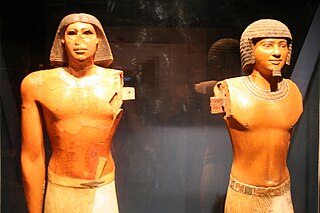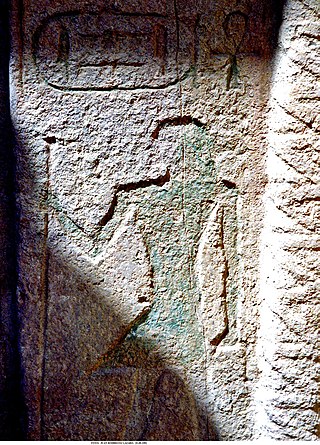Related Research Articles

Neferirkare Kakai was an ancient Egyptian pharaoh, the third king of the Fifth Dynasty. Neferirkare, the eldest son of Sahure with his consort Meretnebty, was known as Ranefer A before he came to the throne. He acceded the day after his father's death and reigned for eight to eleven years, sometime in the early to mid-25th century BCE. He was himself very likely succeeded by his eldest son, born of his queen Khentkaus II, the prince Ranefer B who would take the throne as king Neferefre. Neferirkare fathered another pharaoh, Nyuserre Ini, who took the throne after Neferefre's short reign and the brief rule of the poorly known Shepseskare.

Djedkare Isesi was a pharaoh, the eighth and penultimate ruler of the Fifth Dynasty of Egypt in the late 25th century to mid-24th century BC, during the Old Kingdom. Djedkare succeeded Menkauhor Kaiu and was in turn succeeded by Unas. His relationship to both of these pharaohs remain uncertain, although it is often conjectured that Unas was Djedkare's son, owing to the smooth transition between the two.

Ptahhotep, sometimes known as Ptahhotep I or Ptahhotpe, was an ancient Egyptian vizier during the late 25th century BC and early 24th century BC Fifth Dynasty of Egypt. He is credited with authoring The Maxims of Ptahhotep, an early piece of Egyptian "wisdom literature" meant to instruct young men in appropriate behavior.
Khufukhaf I was an ancient Egyptian prince and vizier of the 4th Dynasty.

Isesi-ankh was an ancient Egyptian high official during the second half of the Fifth Dynasty, in the late 25th to mid 24th century BC. His name means "Isesi lives". He may have been a son of pharaoh Djedkare Isesi and queen Meresankh IV, although this is debated. Isesi-ankh probably lived during the reign of Djedkare Isesi and that of his successor Unas. He was buried in a mastaba tomb in north Saqqara, now ruined.

Rashepses was a vizier from the Fifth Dynasty of Egypt. Rashepses was vizier under Djedkare Isesi. A letter directed to Rashepses has been preserved. This decree is inscribed in his tomb in Saqqara. As vizier he was one of the most important Ancient Egyptian officials. In his tomb are many titles recorded. It seems that he was first overseer of the scribes of the royal documents, overseer of the two granaries and overseer of all royal works. These are all very important titles, making him an influential official at the royal court. At the final stage of his career he became vizier. The vizier title is only preserved in two letters that are copied on the decoration of the tomb. It seems that most of his tomb was finished and after all that, he was promoted.

Akhethetep was a high dignitary of ancient Egypt who lived during the Fifth Dynasty around 2400 BC. Akhethotep and his son Ptahhotep Tjefi were senior court officials during the rule of Djedkare and of Unas (Wenis), towards the end of the 5th Dynasty. Akhethetep's titles included that of a vizier, making him to the highest official at the royal court, only second to the king. He was also overseer of the treasuries, overseer of the scribes of the king's documents and overseer of the granaries. Akhethetep was the son of Ptahhotep. His father was vizier too.
Kaemtjenent was an ancient Egyptian official under pharaoh Djedkare Isesi in the late Fifth Dynasty, during the Old Kingdom period.

Seshemnefer was an ancient Egyptian official of the Fifth Dynasty, most likely under king Djedkare Isesi. At the end of his career he became vizier, the highest office in Ancient Egypt, second only to the king.
Ptahhotep Desher was an Ancient Egyptian official at the end of the Fifth Dynasty, most likely in office under kings Menkauhor Kaiu and Djedkare Isesi. His main function was that of a vizier. This was the most important office in Ancient Egypt, second only to the king. Ptahhotep also held other titles, such as overseer of the six great houses, overseer of the scribes of the royal documents and overseer of all royal works. These are all important functions, often held by a vizier.

Pehenuikai was an Ancient Egyptian official of the Fifth Dynasty. His main office was that of a vizier, making him to the most important man at the royal court, only second to the king. Beside being vizier, he was also holding many other important titles, such as Overseer of the treasuries, overseer of the scribes of the king's document, overseer of the double granary and overseer of all royal works of the king.
Kay was an Ancient Egyptian official living most likely in the Fifth Dynasty. He is mainly known from his mastaba in Saqqara North. Kay held a high number of important titles making him the most powerful person of his time, only second to the king. His main office was that of a vizier. Besides being vizier, he also held many other important titles, such as Overseer of the treasuries, Overseer of Upper Egypt, overseer of the scribes of the king's document, overseer of the six big houses and overseer of all royal works of the king. His mastaba in Saqqara was recorded by Gaston Maspero who assigned to it the number D 19. Kay bore 51 titles, making him the vizier with the highest number of titles. Kay was the first Egyptian official with the title overseer of the six big houses. The office became one of the most important at the royal court in the later Fifth Dynasty and continued to be so during the subsequent Sixth Dynasty . The dating of Kay is uncertain. No biography is preserved in his tomb, no king's name is mentioned. A date in the middle of the Fifth Dynasty has been proposed. Others prefer a date in the early Fifth Dynasty.
Washptah, with the second name Izi, was an ancient Egyptian official in the Fifth Dynasty under king Neferirkare Kakai. His most important title was that of a vizier, making him to the most important official at the royal court, only second to the king. Next to the office of the vizier he hold several other important positions, including overseer of the scribes of the king's document and overseer of all royal works.
Seshathetep, also called Heti, was an ancient Egyptian official at the beginning of the Fifth Dynasty. Seshathetep held many important titles, possibly including that of vizier. With this latter title, he would have been the most important official at the royal court, second only to the king. He also bore the title of king's son of his body, yet it is doubtful that Seshathetep was the real son of a king.
Sekhem-ankh-Ptah was an ancient Egyptian high official who lived during the Old Kingdom period. His main title was that of a vizier, making him the most important official at the royal court, second only to the king. Other important titles of Sekhem-ankh-Ptah were "Overseer of all royal works" and "Overseer of the scribes of the king's document".
Ptahhotep Tjefi, also called Ptahhotep II was an ancient Egyptian official who lived at the end of the Fifth Dynasty, most likely under king Djedkare Isesi and under king Unas. His main function at the royal court was that of the vizier, making him to the most important man at the court, only second to the king. Ptahhotep, whose second name was Tjefi, came from an influential family. His father was the vizier Akhethetep. His grandfather was the vizier Ptahhotep (I). Ptahhotep is mainly known from his mastaba at Saqqara. The burial complex was built for him and his father Akhethetep.
Ptahhotep was an ancient Egyptian official of the Fifth Dynasty, most likely under king Djedkare Isesi. His most important office was that of a vizier, making him to the most important official at the royal court, only second to the king. Next to this important office he held further important titles, such as overseer of the treasuries, overseer of the scribes of the king's document, overseer of the six big houses and overseer of all royal works of the king.
Akhethetep Hemi was an ancient Egyptian official at the end of the Fifth Dynasty, most likely in office under king Unas. His highest title was that of a vizier, making him the most important official at the royal court, only second to the king. Next to the vizier's titles he was also overseer of the treasuries, overseer of the scribes of the king's document and overseer of the double granary; all these were important positions at the royal court.
Ihy was an Ancient Egyptian official of the Fifth Dynasty, in office most likely under king Unas. Ihy was vizier and was therefore the most important official at the royal court only second to the king. Next to the titles of a vizier, he was also overseer of the treasuries, overseer of the scribes of the king's document, overseer of all royal works and overseer of the double granary. These are also important titles, demonstrating his important position at the royal court.
Niankhba was an ancient Egyptian official from the end of the Fifth Dynasty, in office under king Unas. Niankhba was vizier and was therefore the most important official at the royal court. Niankhba is known from his mastaba next to the pyramid of king Unas. The mastaba was found heavily destroyed. His name and titles are only known from the inscriptions found in the burial chamber. The walls of the burial chamber were decorated. The sarcophagus in the burial chamber was inscribed.
References
- ↑ Strudwick 1985, p. 115.
- ↑ el-Fikey 1980, p. 11.
- ↑ el-Fikey 1980, pp. 44–46.